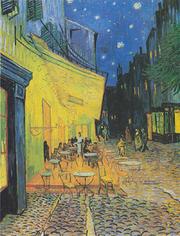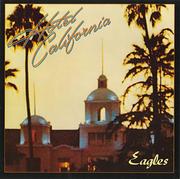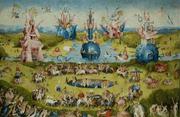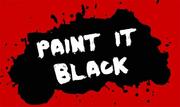Meaning & Analysis: Starry Night Over the Rhone by Vincent Van Gogh
BY K Shabi Updated 12 Oct 2021 PUBLISHED 17 Jun 2013
One of the most popular artists known today, Vincent Van Gogh is perhaps most famous for his "starry night" paintings, including both his masterpiece Starry Night (1889) and its predecessor, Starry Night Over the Rhone, painted in September 1888. While the secret meaning of Starry Night is often debated and analyzed, less analysis and interpretation is given to the meaning behind Starry Night Over the Rhone, one of Van Gogh's first starry night paintings. What is the hidden meaning of Starry Night Over the Rhone by Vincent Van Gogh?

Where is Starry Night?
As an artist, Vincent Van Gogh was fond of painting places and locations that had personal meaning and were familiar to him. Many art history scholars believe that Starry Night (1889) commemorates the view Van Gogh had from his window during his hospitalization in the mental asylum in Saint-Remy, France. Painted just a year before that, Starry Night Over the Rhone most likely captures the view Van Gogh enjoyed of the Rhone River not far from The Yellow House, the home he rented in Place Lamartine in Arles. Although Starry Night is more famous, Starry Night Over the Rhone may memorialize a happier moment in Van Gogh's life and biography.
Analysis of Van Gogh's 1888 Letter about Starry Night Over the Rhone
A personal letter Van Gogh wrote to his friend Eugene Boch in 1888 offers more depth to understanding the meaning of Starry Night Over the Rhone. In the letter, Van Gogh talks conversationally to his friend about refurnishing his apartment, commenting on the "cheerful" atmosphere of his new home. The artist also mentions how busy he is working on new paintings, his artistic creativity and productivity during this period perhaps partly accounting for his high spirits. In his letter, Van Gogh also includes a sketch and a description of a new piece of art he is working on, a study that would later become the oil painting Starry Night Over the Rhone.

Van Gogh’s careful description of his new painting reveals how important color was to him as a painter and visual artist. Mentioning no less than twelve colors, the artist offers an enthusiastically exhaustive account of the color palette he will use in the final oil painting. In letters written to his brother, Theo, Van Gogh also often describes his paintings foremost in terms of color.
In some ways, Starry Night Over the Rhone works as a representational painting of the Rhone River in Arles, France as it looked in 1888. Art history scholars have identified the view seen in the painting as being only a 2-minute walk away from The Yellow House. Van Gogh might have taken in this very view on a daily basis. Like wheat fields, cypresses and daffodils, Van Gogh liked to paint places and things that were familiar to him. But how true to life is Van Gogh’s depiction of this scene in comparison with reality?
Unlike Starry Night, the landscape of Starry Night Over the Rhone is illuminated with more than just the lights of the starry sky. In his letter to Boch, Van Gogh comments on the influence of the “gas jets” in his new painting, comparing their “brutal gold” artificial light somewhat unfavorably with the more “discreet” natural light cast by the stars. Seen reflecting in the waters of the Rhone, the gas streetlights were a new addition to the city of Arles, a modernization lighting up the city's streets at night for the first time. While it is no secret that Van Gogh loved starlight most of all, it is interesting that the artist chose to include this modern novelty in Starry Night Over the Rhone.
More than just a jumble of stars, Van Gogh wanted his starry night painting to include real, recognizable astrological features. Van Gogh's treatment of Ursa Major, also known as the Great Bear constellation, in Starry Night Over the Rhone is significant for a few reasons. As an artist, Van Gogh is often characterized as being more concerned with expressing his inner emotions than realistically portraying objects and landscapes as they are. His concern with representing the Great Bear constellation in this starry night painting at first seems to cast the painter in a different, more objective light. But is that really true?
Was Van Gogh really interested in painting his landscapes true to life? Some have pointed out that his placement of the Great Bear in the sky in Starry Night Over the Rhone is in fact inaccurate in relation with this view of the Arles cityscape. Van Gogh most likely painted the scene en plein air from the riverbanks, perhaps with candles tucked into the brim of his hat, looking out over the water and sky. However, from this view of the east side of the Rhone, the Plough of the Great Bear constellation could not be visible. Why did Van Gogh include it here anyway? The Great Bear also appears in Starry Night and Café Terrace at Night. The constellation must have held sentimental value or significance for the artist, appealing to him for some secret reason. In this way, we can see that Van Gogh is an artist more interested in painting scenes imbued with personal meaning than documenting landscapes strictly as they are.
Meaning of Vincent Van Gogh's Starry Night Over the Rhone?
After carefully describing the landscape of Starry Night Over the Rhone, Van Gogh finally turns his attention to the small couple huddling in the foreground, what he refers to as "two colorful figurines of lovers." While Van Gogh has famously painted starry skies before, Starry Night Over the Rhone stands apart from his other starry night landscape because it features two distinct human figures, however small they may be.
Starry Night Over the Rhone Meaning: A Self-Portrait of the Artist?
Who are the man and woman featured in the foreground of Starry Night Over the Rhone? While the woman dresses in the Parisian fashion of the era, the man wears a wide-brimmed yellow hat. Is this man in the yellow hat Vincent Van Gogh? Van Gogh painted himself wearing a similar hat in Self-Portrait with Straw Hat in 1887, just a year before. Could it be that the artist is in fact one of his lover figurines?
Van Gogh may have been commemorating a happy night from his own life in Starry Night Over the Rhone. In another personal letter, Van Gogh seems to reflect on this particular scene, writing, “Once I went for a walk along the deserted shore at night. It was not cheerful, it was not sad. It was beautiful.” Perhaps walking home after a dinner date, the couple walk close together and take in the dazzling view along the banks of the scenic Rhone River, illuminated by the gaslights and the stars above. Painted in the same colors as the water and sky, the couple blend in easily to the surrounding river scene. The man and woman almost seem to become part of the glittering landscape around them.

Meaning and Interpretation of Starry Night Over the Rhone
What is the true meaning of Starry Night Over the Rhone? The painting may conceal an uncharacteristically romantic meaning for the artist who painted mostly landscapes. According to Van Gogh, this starry night scene is not defined by emotional adjectives like "cheerful" or "sad," but may be an attempt by the artist to capture Beauty, a traditional goal of art. Was this Van Gogh's new personal artistic goal at this time, as he worked on his famous starry night paintings? That's up for interpretation. But to quote Van Gogh’s words, the view is indeed beautiful.







